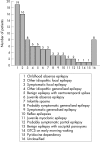Diagnoses made in a secondary care "fits, faints, and funny turns" clinic
- PMID: 16492885
- PMCID: PMC2065949
- DOI: 10.1136/adc.2004.062455
Diagnoses made in a secondary care "fits, faints, and funny turns" clinic
Abstract
Aims: To investigate the diagnoses made for children referred to a "fits, faints, and funny turns" clinic.
Methods: Prospective study of 380 children referred to a dedicated secondary care clinic over an eight year period.
Results: Twenty three per cent of children were given a final diagnosis of one of the childhood epilepsies, with 48% of these having a specific epilepsy syndrome. Syncope was the commonest cause of a non-epileptic event (syncope and reflex anoxic seizures comprised 100/238, 42%) but there were a wide variety of other causes. Fifty three events (14%) were unclassified and managed without a diagnostic label or treatment.
Conclusions: In children with funny turns referred to secondary care, the diagnostic possibilities are numerous; among non-epileptic events, syncopes predominate. The majority do not have epilepsy. Unclassifiable events with no clear epileptic or non-epileptic cause are common and can be safely managed expectantly.
Conflict of interest statement
Competing interests: none declared
Comment in
-
Preventing misdiagnosis of epilepsy.Arch Dis Child. 2006 Mar;91(3):206-9. doi: 10.1136/adc.2005.088906. Arch Dis Child. 2006. PMID: 16492881 Free PMC article. Review.
Similar articles
-
Fits, faints and funny turns in children.Aust Fam Physician. 2005 Dec;34(12):1003-8. Aust Fam Physician. 2005. PMID: 16333481 Review.
-
Diagnostic inaccuracy in children referred with "first seizure": role for a first seizure clinic.Epilepsia. 2007 Jun;48(6):1062-6. doi: 10.1111/j.1528-1167.2007.01018.x. Epilepsia. 2007. PMID: 17553117
-
[Non-epileptic paroxysmal neurologic disorders in children].Rev Med Suisse Romande. 1978 Apr;98(4):167-75. Rev Med Suisse Romande. 1978. PMID: 653182 French. No abstract available.
-
Clinical management. Fits, faints and funny turns.J R Nav Med Serv. 1997;83(2):76-8. J R Nav Med Serv. 1997. PMID: 9684449
-
The borderland of epilepsy: clinical and molecular features of phenomena that mimic epileptic seizures.Lancet Neurol. 2009 Apr;8(4):370-81. doi: 10.1016/S1474-4422(09)70059-6. Lancet Neurol. 2009. PMID: 19296920 Review.
Cited by
-
Reflex anoxic seizures (RAS) in an adult patient: a separate entity from epilepsy.BMJ Case Rep. 2018 May 8;2018:bcr2017222389. doi: 10.1136/bcr-2017-222389. BMJ Case Rep. 2018. PMID: 29739759 Free PMC article.
-
Current approaches to the clinical assessment of syncope in pediatric population.Childs Nerv Syst. 2016 Mar;32(3):427-36. doi: 10.1007/s00381-015-2988-8. Epub 2016 Jan 5. Childs Nerv Syst. 2016. PMID: 26732063 Review.
-
NICE guidelines and the epilepsies: how should practice change?Arch Dis Child. 2006 Jun;91(6):525-8. doi: 10.1136/adc.2005.080036. Arch Dis Child. 2006. PMID: 16714728 Free PMC article. Review.
-
FALSE PHARMACORESISTANCE - A TRUE PROBLEM.Acta Clin Croat. 2021 Dec;60(Suppl 3):9-15. doi: 10.20471/acc.2021.60.s3.01. Acta Clin Croat. 2021. PMID: 36405004 Free PMC article. Review.
-
Preventing misdiagnosis of epilepsy.Arch Dis Child. 2006 Mar;91(3):206-9. doi: 10.1136/adc.2005.088906. Arch Dis Child. 2006. PMID: 16492881 Free PMC article. Review.
References
-
- Scheepers B, Clough P, Pickles C. The misdiagnosis of epilepsy: findings of a population study. Seizure 19987403–406. - PubMed
-
- Smith D, Defalla B A, Chadwick D W. The misdiagnosis of epilepsy and the management of refractory epilepsy in a specialist clinic. QJM 19999215–23. - PubMed
-
- Gibbs J, Appleton R E. False diagnosis of epilepsy in children. Seizure 1992115–18. - PubMed
-
- Appleton R. Misdiagnosis occurs particularly in children. BMJ 20023241219 - PubMed
-
- Royal College of Paediatrics and Child Health, College Special Advisory Committee in Paediatric Neurology Independent performance review of Dr Andrew Holton, Leicester Royal Infirmary. London: RCPCH, 2001




